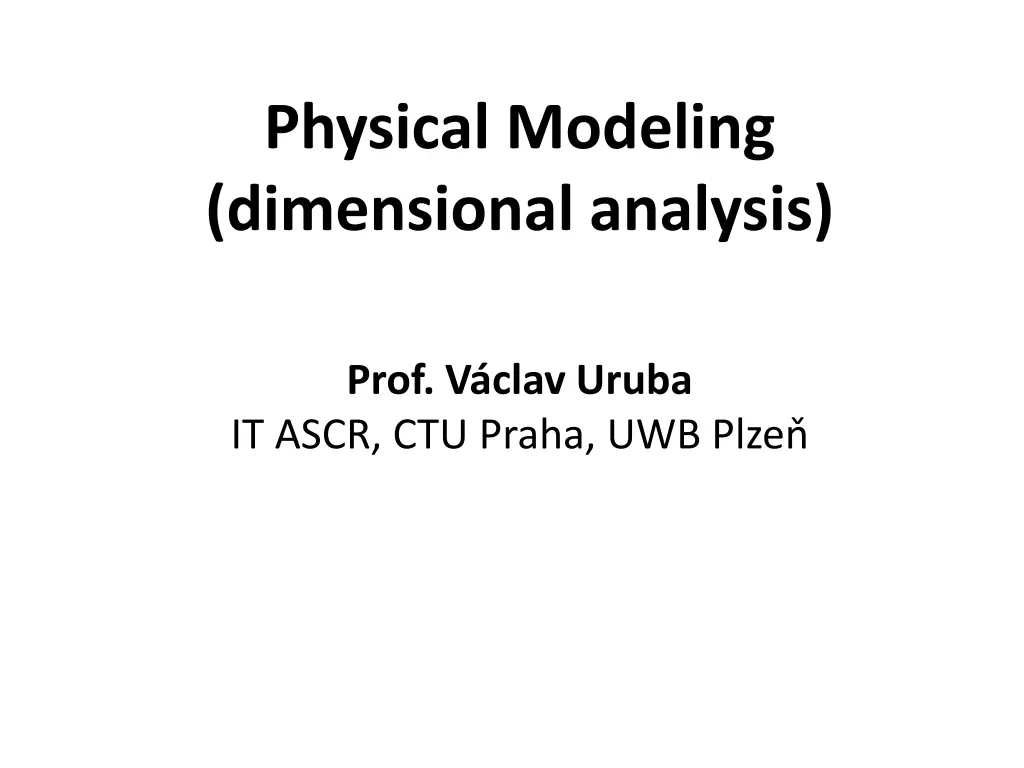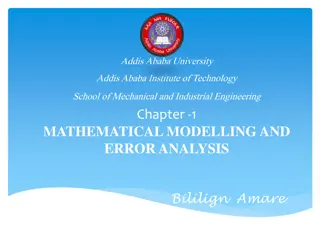
Physical Modeling & Dimensional Analysis in Physics
Explore the world of physical modeling and dimensional analysis in physics, including the importance of experiments, mathematical modeling, validation, and system of physical dimensions. Learn about key figures, principles, theorems, and non-dimensional quantities relevant to experimental modeling. Discover the application of Buckingham's Theorem in simplifying physical variables and models, along with the significance of nondimensional numbers in mechanics of fluids.
Download Presentation

Please find below an Image/Link to download the presentation.
The content on the website is provided AS IS for your information and personal use only. It may not be sold, licensed, or shared on other websites without obtaining consent from the author. If you encounter any issues during the download, it is possible that the publisher has removed the file from their server.
You are allowed to download the files provided on this website for personal or commercial use, subject to the condition that they are used lawfully. All files are the property of their respective owners.
The content on the website is provided AS IS for your information and personal use only. It may not be sold, licensed, or shared on other websites without obtaining consent from the author.
E N D
Presentation Transcript
Physical Modeling (dimensional analysis) Prof. V clav Uruba IT ASCR, CTU Praha, UWB Plze
WHY Experiments Physical Modelling Experiments Mathematical Modelling CFD Verification The process of determining that a computational model accurately represents the underlying mathematical model and its solution Validation The process of determining the degree to which a model is an accurate representation of the real world from the perspective of the intended uses Boundary condition Inlet, walls, outlet ASME V&V Guide EXPERIMENTS August 21, 2025 2
Experimental modeling in physics Isaac Newton (1686) - Great Principle of Similitude James Clerk Maxwell - 19th-century physicist Joseph Fourier - 19th-century French mathematician Rayleigh's method of dimensional analysis Buckingham theorem (1914) August 21, 2025 3
System of physical dimensions SI system - 7 fundamental quantities units: Kilogram Meter Candela Second Ampere Kelvin Mole Fluid Mechanics Termodynamics August 21, 2025 4
Nondimensional quantities Q Q j = Simplex: P i k Complex: = n b n b b 2 ... Q Q Q 1 2 1 i August 21, 2025 5
Buckingham's Theorem n physical variables q1, ,qn Model: f(q1, ,qn) = 0 k fundamental physical units p = n k dimensionless parameters complex 1, , p Model: F( 1, , p) = 0 Plus simplex Pi August 21, 2025 6
Buckingham's Theorem The mathematical model not necessary Only relevant quantities BT provides method Dimensional matrix Not unique chose the most physically meaningful August 21, 2025 7
Nondimensional numbers in Mechanics of Fluids UL UL Reynolds number Inertial forces Viscous forces = = Re U a Mach number = Compressibility effects M fL U Strouhal number Nondimensional frequency = St F F A U = = C Force coefficients , D L 2 0,5 Ap d August 21, 2025 8
Nondimensional numbers in Thermodynamics convective heat transfer coefficient Nusselt number hL k thermal conductivity = Nu Convective heat transfer coeff. Conductive heat transfer coeff. Prandtl number kinematic viscosity thermal diffusivity = Pr Momentum diffusivity Thermal diffusivity Schmidt number kinematic viscosity Viscous diffusion rate Molecular (mass) diffusion rate = Sc D mass diffusivity August 21, 2025 9
Physical modeling object model parameters results Similarity Geometrical (simplex) Physical (complex) August 21, 2025 10
Physical modeling UL UL Reynolds number = = Re U a Mach number = M Modelling 1 U U U L L ! = = = Re Re m o L L scale= 1 = m o m scale scale o m o = = M M U m o m o August 21, 2025 11
Example sphere in flow Relevant quantities F[kg.m/s2], V[m/s], d[m], [kg/m3], [m/s2], a[m/s] F = f(V,d, , ,a) Nondimensional parameters: Re Vd V a F = = 1 2 2 1 2 2 V d 4 = P M CD 1 August 21, 2025 12






















